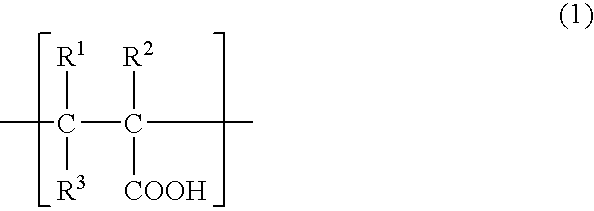Aqueous ink for mimeograph printing and method for mimeograph printing
a technology of mimeograph printing and water-based ink, which is applied in the direction of inks, liquid surface applicators, coatings, etc., can solve the problems of insufficient contact with the atmosphere of water within the ink transferred to the print medium, inability to penetrate particularly fast, and inability to completely dry the ink immediately after printing
- Summary
- Abstract
- Description
- Claims
- Application Information
AI Technical Summary
Problems solved by technology
Method used
Image
Examples
example 1
[0053] 6.0% of carbon black (MCF88, manufactured by Mitsubishi Chemical Corporation) as a colorant, 1.3% of polyvinylpyrrolidone (K90, manufactured by Dai-ichi Kogyo Seiyaku Co., Ltd.) as a pigment dispersing agent, and 20.0% of distilled water were mixed together, and were then dispersed thoroughly using a beads mill, thus yielding a pigment dispersion. 0.5% of polyacrylic acid (Junlon PW150, manufactured by Nihon Junyaku Co., Ltd.) as a thickener was then dissolved in 16.0% of distilled water, and following neutralization of the resulting solution by addition of 10.0% of a 2% aqueous solution of sodium hydroxide, the neutralized solution was combined with the previously prepared pigment dispersion, 16.0% of triethylene glycol, and the remaining quantity of distilled water (30.2%), and the resulting combination was then mixed thoroughly, yielding an ink of the example 1.
examples 2 to 6
, Comparative Examples 1 to 4
[0054] With the exception of using the compositions shown in Table 1, inks for each of the examples and comparative examples were prepared in the same manner as the example 1.
PUM
| Property | Measurement | Unit |
|---|---|---|
| viscosity | aaaaa | aaaaa |
| water-soluble | aaaaa | aaaaa |
| time | aaaaa | aaaaa |
Abstract
Description
Claims
Application Information
 Login to View More
Login to View More - R&D
- Intellectual Property
- Life Sciences
- Materials
- Tech Scout
- Unparalleled Data Quality
- Higher Quality Content
- 60% Fewer Hallucinations
Browse by: Latest US Patents, China's latest patents, Technical Efficacy Thesaurus, Application Domain, Technology Topic, Popular Technical Reports.
© 2025 PatSnap. All rights reserved.Legal|Privacy policy|Modern Slavery Act Transparency Statement|Sitemap|About US| Contact US: help@patsnap.com

